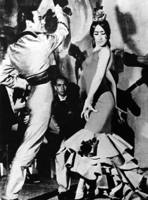
|
The Society of Folk Dance Historians (SFDH)
Choreogeography:
[
Home |
About |
Encyclopedia | CLICK AN IMAGE TO ENLARGE |

|
 Spain is one of the most interesting countries of Europe for the dance ethnologist and folklorist. Few countries are so linked to our world in a historical thread beginning with Columbus and, through him, to Ferdinand and Isabella and the Moors before them.
Spain is one of the most interesting countries of Europe for the dance ethnologist and folklorist. Few countries are so linked to our world in a historical thread beginning with Columbus and, through him, to Ferdinand and Isabella and the Moors before them.
Spanish dance is a vivid enactment of the personality of Spanish people: intense, impulsive, quick to anger or love, seemingly hiding nothing of their lust for life. It has been said that in a country of sharp contrasts in light and climate, as Spain is, sharp contrasts in temperament are to be expected. And so it is.
Of course, Flamenco is the most well-known of all Spanish dances; alas, not Spanish at all, rather the tradition of Spain's disenfranchised Romani people of the South, believed by many to be descendant of the Moors. Accompanied by the "jaleo," a combination of guitar, soul-searing song, and hypnotizing palmadas, the Romani dancer acts out the anguish of poverty and the intense urges of anger, pain, lust, and domination. The famous Zapateado can be traced to the Moors who Ferdinand and Isabella removed from Spain the year of Columbus' voyage. Flamenco is a great tourist attraction in Andalucia, southern Spain, and many have sought in vain for the real Flamenco, to no avail.
It is said that in Andalucia, "half the population contemplates the Zapateado, while the other half creates it." Little wonder that the dance of Andalucia in southern Spain, the sophisticated and highly developed Sevillanas, is the most important social dance, raised to a form of high art. This is the dance one envisions when Spain is mentioned. Here is the ultimate development of the castanet, its complex rhythms adding fire to this happy, spirited dance and Andalucian women compete as equal partners in the dance, giving and demanding on equal terms with their partners. The carriage is proud, even arrogant, the upper body the major focus, accented by sweeping gestures of the legs and intermittent sharp Zapateados. The figures end with a spiraling pass by the partner, ending in a graceful pose, one arm high over head, back arched, gazing triumphantly, defiantly at the partner. There is no more vivid portrayal of Spanish life.
 In the interior, Castile's warm, dry climate creates a milder, less animated dance. Women dance with sophisticated restraint and poise, as would appear proper in the political center of the country. The Bolero and Fandango are most well-known, characterized by a quiet, erect upper carriage and rapid, intricate footwork by both partners.
In the interior, Castile's warm, dry climate creates a milder, less animated dance. Women dance with sophisticated restraint and poise, as would appear proper in the political center of the country. The Bolero and Fandango are most well-known, characterized by a quiet, erect upper carriage and rapid, intricate footwork by both partners.
In Estramadura to the west, bordering Portugal, Moorish influence is still evident in dance and song. It is from this poor region that many of the Conquistadores came, seeking their fortune in the New World. It is certain that many of the Spanish families of Spanish California originally came from Estramadura, performing their dances in California's haciendas. The Jota is danced here in an earthy style, arms extended upward as the horns of the bull and the upper body still in deference to the elaborate footwork.
The Levantine, which includes Valencia and Murcia, reveals in its dance influences from ancient Greece and Rome, even the Moors. Dances are dignified and elegant, many revealing their Renaissance origins. The men's costume even has features of Greece and the Balkans. The Jota is the major dance, aristocratic in character, not as lively as in the cooler north, but more so than in the warmer south.
Northern Spain's cooler climate produces more energetic dance forms, claimed by locals to be the oldest in Spain. Where dance is a solo demonstration in the south, it is a collective activity in the north, involving couples in circles and sets. Women continue to dance with downcast modesty in strong contrast to their aggressive southern counterparts.
To the east in Navarre and Aragon, the Jota reaches its peak of perfection. These people are above all, independent, proud, stubborn, forceful, and energetic and they dance the Jota as if there were no gravity. Such is the character of vigorous mountain folk throughout Europe.
Finally to Catatonia, wedged in the easternmost corner of Spain; the Sardana is the most well-known dance, a circle dance probably of Greek origin. It is danced in a series of long and short figures, each dancer expected to move exactly the same as the others. The music is usually played on instruments from the Renaissance. The Sardana became a symbol of resistance to the Francan government, which had attempted to replace the Catalonian language with Spanish. It is still danced in sincere expression of Catalonian independence.
DOCUMENTS
- Richard Duree, an article.
- Spain, a country.
Used with permission of the author.
This page © 2018 by Ron Houston.
Please do not copy any part of this page without including this copyright notice.
Please do not copy small portions out of context.
Please do not copy large portions without permission from Ron Houston.